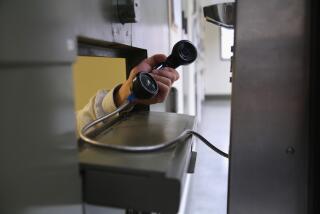Call-Box Dispatchers Face Tangle of Tongues
Orange County’s year-old system of freeway telephones has a problem--the dispatchers at California Highway Patrol headquarters in Santa Ana can’t understand many of the callers.
The 1,134 call boxes spaced every quarter of a mile along all the county’s freeways received a record 13,500 calls last month. About 10% of the callers, as many as 100 on some days, spoke only foreign languages, mostly Spanish and Vietnamese.
The dispatchers, however, speak only English.
“From the start, the number of people calling in foreign languages has surprised us,” said Todd Murphy, chairman of California SAFE (Service Authority for Freeway Emergencies), which handles wireless call boxes in California.
Murphy said that when the telephone service was launched last September, officials expected to receive some calls in Spanish but never anticipated the volume and diversity of foreign language calls.
A translation center was retained to deal with non-English-speaking callers. When foreign language calls come into Santa Ana, the caller is patched into the translation facility--Communications and Language Line, based in Monterey, Calif.--and a three-way conversation takes place.
Company officials say they receive more demands for translation from Orange County than anywhere else freeway phones are used.
“From the very start we found that Orange County runs 30 to 40 different languages every month, about the same as in New York City,” said Mike McFerrin, information manager for Communications and Language Line, which can translate in 143 languages. “We get more calls from call boxes in Orange County than we do from anywhere in the country.”
Although the center has had to deal with Orange County callers who speak only such languages as Romanian and Farsi, about half the foreign language calls are in Spanish. While they can still hook up by telephone with the translation service, Highway Patrol officials say they need Spanish speakers on staff to handle the
heavy volume.
“The translation service is great, but it’s costly and slower than having somebody on hand,” said Lt. Rick Criner, manager of the Santa Ana communications center. “We need somebody on staff.
“It’s much better to have bilingual people on hand rather than to try and sort things out over three telephone lines. They are faster and they can save lives if they know CHP policies and procedures.”
Criner said the telephone center has had difficulty attracting Spanish-speaking applicants and that CHP regulations have hampered the hiring of Spanish speakers. Under department rules, bilingual dispatchers can be paid more after they are hired but can only be given preference in hiring if they are among the top three candidates, he said.
Last January, the CHP allocated extra money to be paid to two Spanish-speaking dispatchers in the Santa Ana office, but so far none has been hired. In June, the department held its first ever bilingual test for dispatchers. Of 20 applicants, four qualified and have been listed for hire, said CHP spokesman Keith Thornhill.
Orange County began to install the call-box system in 1987 after the area’s 26 municipalities approved a $1 surcharge on motor vehicle registration to pay for it. About $5.4 million was spent just to install the telephones that went on line in June, 1988, and were completed last September.
Meanwhile, other counties in California will be watching to see how Orange County deals with the problem. Although only Orange, San Diego and Los Angeles counties now have call boxes, more than a dozen other counties, including Riverside, expect to start the service in the next few years.
By 1991, though, there should be 15,000 call boxes in the state, Murphy said.
“This system is the best we can do for now,” said Murphy. “It helps drivers help themselves.”
COUNTY CALL BOXES
The Orange County call box system was the first in the state to begin operation under the California SAFE (Service Authority for Freeway Emergencies) program last June. Since then, California Highway Patrol authorities in Santa Ana have found that about 10% of the 8,000 to 13,000 calls each month are in languages operators can’t understand without a translator.
Total call boxes in O.C.: 1,124
Calls per week: about 2,000
Cost to build: $5.2 million
Total calls requiring a translator in June: 828
Average number of languages other than English each month: 30-40
Full-time positions for answering call-box calls: 6
Source: California Highway Patrol and SAFE
More to Read
Sign up for Essential California
The most important California stories and recommendations in your inbox every morning.
You may occasionally receive promotional content from the Los Angeles Times.









